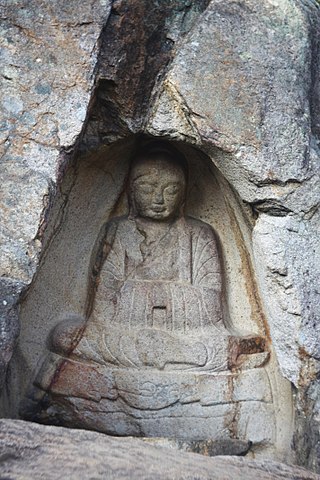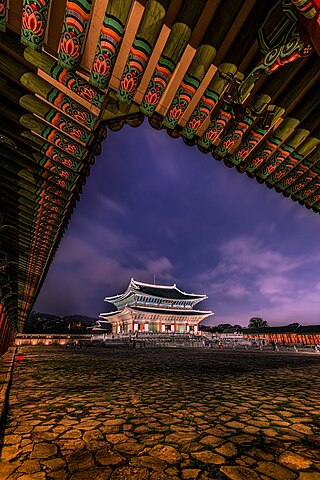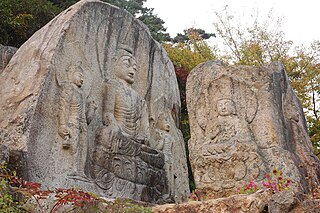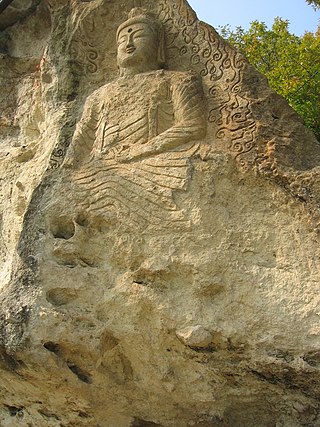
A pagoda is an East Asian tiered tower with multiple eaves common to Nepal, China, Japan, Korea, Myanmar, Vietnam, and other parts of Asia. Most pagodas were built to have a religious function, most often Buddhist but sometimes Taoist, and were often located in or near viharas. The pagoda traces its origins to the stupa of ancient India.
Buddhist temples are an important part of the Korean landscape. This article gives a brief overview of Korean Buddhism, then describes some of the more important temples in Korea. Most Korean temples have names ending in -sa, which means "temple" in Sino-Korean.

Bulguksa is located on the slopes of Mount Toham. It is a head temple of the Jogye Order of Korean Buddhism and encompasses six National treasures of South Korea, including the Dabotap and Seokgatap stone pagodas, Cheongun-gyo, and two gilt-bronze statues of Buddha. The temple is classified as Historic and Scenic Site No. 1 by the South Korean government. In 1995, Bulguksa was added to the UNESCO World Heritage List together with the Seokguram Grotto, which lies four kilometers to the east.

Queen Seondeok of Silla reigned as Queen Regnant of Silla, one of the Three Kingdoms of Korea, from 632 to 647. She was Silla's twenty-seventh ruler, and its first reigning queen. She was the second female sovereign in recorded East Asian history and encouraged a renaissance in thought, literature, and the arts in Silla. In Samguksagi, Queen Seondeok was described as "generous, benevolent, wise, and smart". According to the Legend of Jigwi, she was even beautiful.

The Seokguram Grotto is a hermitage and part of the Bulguksa temple complex. It lies four kilometers east of the temple on Mt. Tohamsan, in Gyeongju, South Korea. It is classified as National Treasure No. 24 by the South Korean government and is located at 994, Jinhyeon-dong, Gyeongju-si, Gyeongsanbuk-do. The grotto overlooks the Sea of Japan and rests 750 meters above sea level. In 1962, it was designated the 24th national treasure of Korea. In 1995, Seokguram was added to the UNESCO World Heritage List together with the Bulguksa Temple. It exemplifies some of the best Buddhist sculptures in the world.

A National Treasure is a tangible treasure, artifact, site, or building which is recognized by the South Korean government as having exceptional artistic, cultural and historical value to the country. The title is one of the eight State-designated heritage classifications assigned by the administrator of the Cultural Heritage Administration (CHA) in accordance with the Cultural Heritage Protection Act after deliberation by the Cultural Heritage Committee.

Korean architecture refers to an architectural style that developed over centuries in Korea. Throughout the history of Korea, various kingdoms and royal dynasties have developed a unique style of architecture with influences from Buddhism and Korean Confucianism.

Namsan is a 494-meter peak in the heart of Gyeongju National Park, just south of Gyeongju, South Korea. The mountain is within easy reach from the city and attracts a large number of national tourists. Namsan covers an area of about 8 km (north-south) by 12 km (east-west). Some 180 peaks are counted, of which Geumobong and Gouibong are the best-known. There are about 40 valleys.
Gyeongdeok of Silla was the 35th ruler of Silla and son of King Seongdeok. He succeeded his elder brother, King Hyoseong, the 34th ruler of Silla. His reign is considered a golden age in Unified Silla’s history, particularly for Buddhist art and architecture. He is noted as an intent patron of Buddhism and an influential political and religious individual. King Gyeongdeok also made attempts to centralize the country through reorganizing government and standardizing naming practices. With his mother as regent, Gyeongdeok’s son, King Hyegong, succeeded him after his death.

Golgulsa is located 20 km east of the ancient Silla Dynasty capital city of Gyeongju in Southeastern Korea. In the Golgulsa temple area can be found the oldest historical Buddhist ruins on Mt. Hamwol and the only cave temple in Korea.
Beopheung of Silla was the 23rd monarch of Silla, one of the Three Kingdoms of Korea. He was preceded by King Jijeung and succeeded by King Jinheung.

Beopjusa is a head temple of the Jogye Order of Korean Buddhism. It is situated on the slopes of Songnisan, within Songnisan National Park, in Naesongni-myeon, Boeun County, in the province of Chungcheongbuk-do, South Korea.

Woljeongsa is a head temple of the Jogye Order of Korean Buddhism, located on the eastern slopes of Odaesan in Pyeongchang County, Gangwon Province, South Korea. Woljeongsa was founded in 643 by the Silla monk Jajang.

Geumsansa is a temple of the Jogye Order of Korean Buddhism standing on the slopes of Moaksan in Gimje City, Jeollabuk-do, South Korea.

The Gyeongju Historic Areas of South Korea were designated as a World Heritage Site by UNESCO in 2000. The protected areas encompass the ruins of temples and palaces, outdoor pagodas and statuary, and other cultural artifacts left by the Silla Kingdom. The historic areas are sometimes known as one of the largest outdoor museums in the world.

Bunhwangsa is a temple complex from the Old Silla era of Korea. It is located in Gyeongju. The temple is recorded to have been built in 634 under the auspices of Queen Seondeok. Today the temple is still used by a small group of worshipers but in its heyday, the temple covered several acres and was one of the four main temples of the Silla Kingdom used by the state to ask the Buddha to bless the kingdom. The ruins of Hwangnyongsa Temple lay nearby. It is part of the UNESCO world heritage site Gyeongju Historic Areas.
Korean Buddhist sculpture is one of the major areas of Korean art. Buddhism, a religion originating in what is now India, was transmitted to Korea via China in the late 4th century. Buddhism introduced major changes in Korean society. The complexity of the religious sutras sent to Korea required the aristocrats who adopted the religion to become literate and required the training and importation of literate scribes. Little evidence of religious art exists in Korea before the introduction of Buddhism. Subsequent to its introduction, the religion inspired the production of devotional art as well as the beginnings of sophisticated temple architecture.

The Baengnyulsa or Baengnyul temple is a Korean Buddhist temple located on the slopes of Geumgang Mountain in the neighborhood of Dongcheon-dong, Gyeongju, North Gyeongsang province, South Korea. It is a branch temple of Bulguksa temple, the head temple of the 11th district of the Jogye Order. The foundation date is unknown but is speculated to be around the time when the Silla Kingdom united the Three Kingdoms of Korea in 692 according to both an oral story and a document on a Buddha statue. Baengnyulsa is also believed to be the Jachusa temple which is associated with Ichadon's martyrdom.

Korean pagodas are a traditional Korean architectural form that began in the Three Kingdoms of Korea period. Koreans created a unique and distinct pagoda tradition using stone.

Iksan Mireuksaji Stone Pagoda is located in Mireuksaji, Geumma-myeon, Iksan-si, Jeollabuk-do, and is the oldest stone pagoda remaining in Korea. It is designated as the 11th national treasure.





























